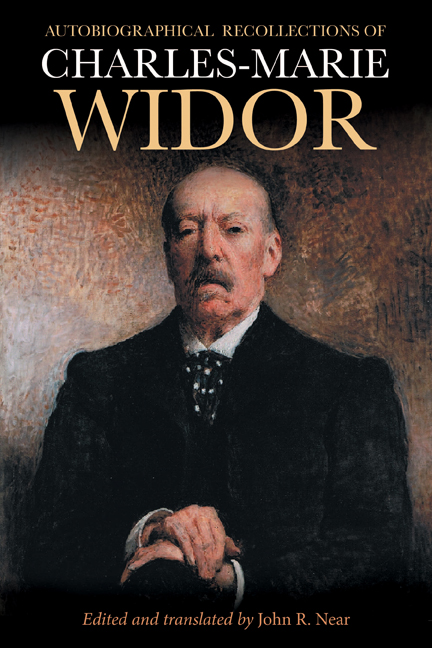Book contents
- Frontmatter
- Contents
- List of Illustrations
- Foreword
- Preface
- Acknowledgments
- Introduction: Tribute to Charles-Marie Widor
- Part One Studies, Early Performances, and Aristide Cavaillé-Coll (1844–69)
- Part Two La Belle Époque: The Franco-Prussian War to The Great War (1870–1914)
- Part Three The Great War and Important Initiatives (1914–37)
- Appendix 1 Birth record of Charles-Marie Widor, 1844
- Appendix 2 Widor’s Diplôme de Bachelier ès Lettres, 1863
- Appendix 3 Widor’s letter of appreciation to Jacques Lemmens, 1863
- Appendix 4 Brussels Ducal Palace organ specification, 1861
- Appendix 5 Widor’s certificate for Chevalier de l’Ordre du Christ, 1866
- Appendix 6 “To Budapest,” 1893
- Appendix 7 Widor’s travels to Russia and his 1903 passport
- Appendix 8 Widor’s list of his works in 1894
- Appendix 9 The Paris Conservatory organs, 1872
- Appendix 10 Chronique [Widor’s appeal for an organ hall at the Paris Conservatory, 1895]
- Appendix 11 Widor’s certificate for the Académie Royale, Brussels, 1908
- Appendix 12 “Debussy & Rodin,” 1927
- Appendix 13 The American Conservatory organ, Fontainebleau, 1925
- Appendix 14 Letters concerning the Trocadéro organ restoration, 1926
- Notes
- Bibliography
- Index
- Eastman Studies in Music
21 - La Concordia
Published online by Cambridge University Press: 09 May 2024
- Frontmatter
- Contents
- List of Illustrations
- Foreword
- Preface
- Acknowledgments
- Introduction: Tribute to Charles-Marie Widor
- Part One Studies, Early Performances, and Aristide Cavaillé-Coll (1844–69)
- Part Two La Belle Époque: The Franco-Prussian War to The Great War (1870–1914)
- Part Three The Great War and Important Initiatives (1914–37)
- Appendix 1 Birth record of Charles-Marie Widor, 1844
- Appendix 2 Widor’s Diplôme de Bachelier ès Lettres, 1863
- Appendix 3 Widor’s letter of appreciation to Jacques Lemmens, 1863
- Appendix 4 Brussels Ducal Palace organ specification, 1861
- Appendix 5 Widor’s certificate for Chevalier de l’Ordre du Christ, 1866
- Appendix 6 “To Budapest,” 1893
- Appendix 7 Widor’s travels to Russia and his 1903 passport
- Appendix 8 Widor’s list of his works in 1894
- Appendix 9 The Paris Conservatory organs, 1872
- Appendix 10 Chronique [Widor’s appeal for an organ hall at the Paris Conservatory, 1895]
- Appendix 11 Widor’s certificate for the Académie Royale, Brussels, 1908
- Appendix 12 “Debussy & Rodin,” 1927
- Appendix 13 The American Conservatory organ, Fontainebleau, 1925
- Appendix 14 Letters concerning the Trocadéro organ restoration, 1926
- Notes
- Bibliography
- Index
- Eastman Studies in Music
Summary
Some Alsatian waifs—refugees in Paris from sacred choral societies in Strasbourg—had asked me on several occasions to conduct a concert for the sake of their works. I practiced conducting choirs and the orchestra on account of this request, and then one day they had the idea of sending their directors to me: Edmond and Henriette Fuchs, both Alsatians. The husband was a very distinguished engineer, and his wife was a musician of the first order. They came to tell me: “We want to permanently reconstitute our former Strasbourg society in Paris. Most of us are Protestants. The Reformed Consistory occupies a house, rue du Louvre, in which there is a large meeting room. Would you be willing for us to form a Society that will be called, as formerly, the Concordia, of which you will be the conductor under the patronage of Gounod?” I accepted with great eagerness as the concerts, in which we had performed a few cantatas by Bach and some interesting pieces by Schumann, had taught me a little about the primary elements of my profession as a conductor. Also, the suggestions of Gounod, who came to hear a rehearsal on the Saturday of the Institute's centennial, had taught me some things of which I was absolutely ignorant: the art of singing Palestrina— that is to say, the art of voices articulating with a certain vigor and not slurring the sounds, the art of making sound carry in a large room, and how to restore clarity to the vocal text when it was being lost with tied and slurred sounds.
We had a series of very fine performances that for the most part took place in the hall of the Conservatory (or Consistory?). We sang the B-Minor Mass, the [Saint-Matthew] Passion, and quite a number of cantatas, with my colleague Alexandre Guilmant at the organ. The Society lasted nearly twenty years and only came to an end because Mme Fuchs, who was its prima donna, had reached the age when her voice no longer had its former freshness; also, the death of her husband caused her profound grief.
- Type
- Chapter
- Information
- Publisher: Boydell & BrewerPrint publication year: 2024

